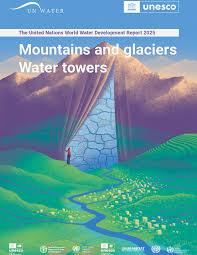United Nations World Water Development Report (WWDR) 2025:

The 2025 UN World Water Development Report says that Retreating glaciers threatens the food and water supply of 2 billion people around the world.
Highlight of the WWDR 2025:
- Theme: Mountains and glaciers – Water towers
- The report says that “all mountain ranges” have shown evidence of warming since the early 20th century.
- It warns that, as global temperatures rise, more mountain precipitation will fall as rain instead of snow, causing snowpacks to thin and melt earlier in the year.
- It finds that receding snow and ice cover in mountain regions could have “severe” consequences for people and nature.
- This acceleration in snowpack melt often causes river flow to increase in glacier-fed water basins and rivers in the short term.
- However, once the snow melts beyond a certain threshold, a “peak water” point is passed and river flow declines again.
- The report says there is “strong evidence” that this “peak water” point has already been passed in the glacial-fed rivers of the tropical Andes, western Canada and the Swiss Alps.
- Meanwhile, many glaciers have disappeared entirely. For example, Colombia has lost 90% of its glacial area since the mid-19th century, according to the report.
- It warns that, as the climate warms, many glaciers will “inevitably” disappear over the coming decades. It points to projections that suggest that warming of 1.5-4C will cause glaciers to lose 26-41% of their 2015 mass by 2100.
- The report highlights a wide range of impacts, including reduced water for drinking and agriculture, stress on local ecosystems and increased risk of “devastating” glacial lake outburst floods (GLOFs).
- Retreating glaciers threatens the food and water supply of 2 billion people around the world.
- Two-thirds of all irrigated agriculture in the world is likely to be affected in some way by receding glaciers and dwindling snowfall in mountain regions, driven by the climate crisis.




